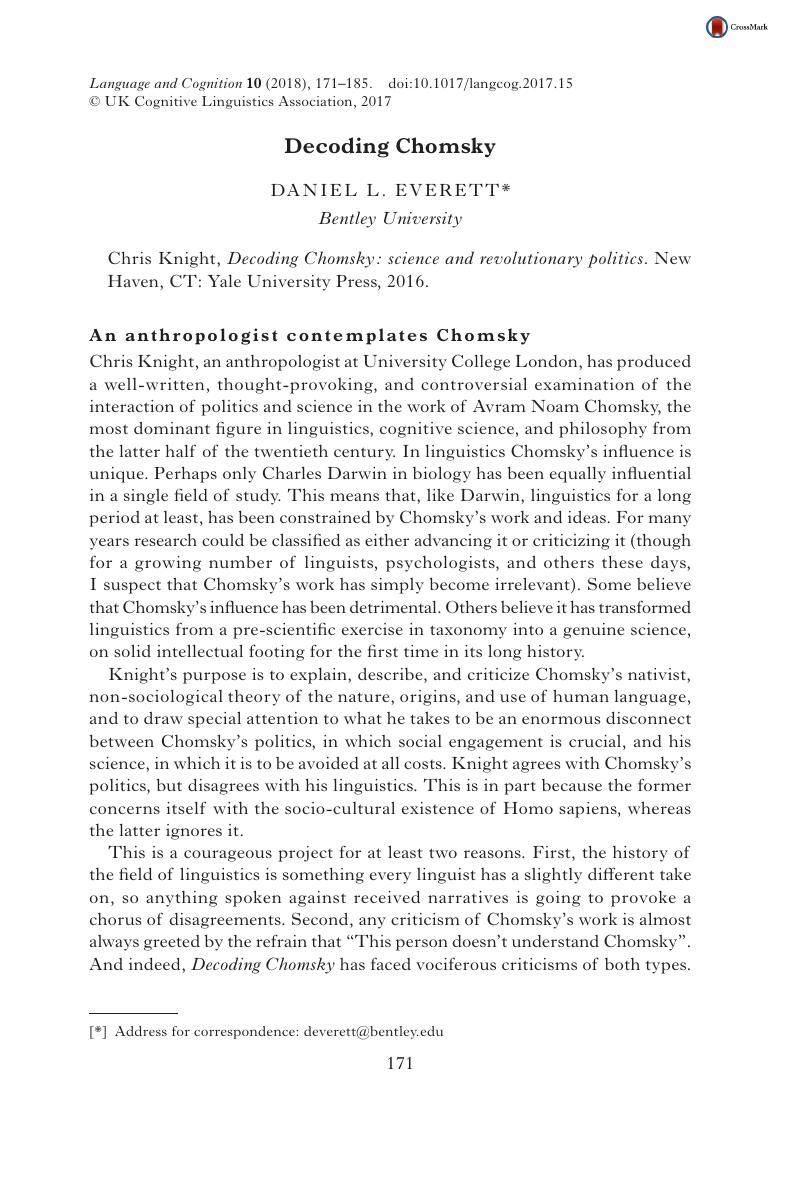No CrossRef data available.
Article contents
Decoding Chomsky
Review products
KnightChris, Decoding Chomsky: science and revolutionary politics.New Haven, CT: Yale University Press, 2016.
Published online by Cambridge University Press: 20 September 2017
Abstract
An abstract is not available for this content so a preview has been provided. Please use the Get access link above for information on how to access this content.

- Type
- Review Article
- Information
- Copyright
- Copyright © UK Cognitive Linguistics Association 2017
References
references
Behme, Christina (2014). A ‘Galilean’ science of language. Journal of Linguistics, 50(3), 671–704.CrossRefGoogle Scholar
Berwick, Robert C., & Chomsky, Noam (2016). Why only us? Language and evolution. Cambridge, MA: MIT Press.Google Scholar
Biber, D., & Finegan, E. (1991). On the exploitation of computerized corpora in variation studies. In Aijmer, K. & Altenberg, B. (Eds.), English corpus linguistics: studies in honour of Jan Svartvik (pp. 204–220). London: Longman.Google Scholar
Blumberg, Marc (2006). Basic instinct: the genesis of behavior. New York: Basic Books.Google Scholar
Brandom, Robert (1998). Making it explicit: reasoning, representing, and discursive commitment. Cambridge, MA : Harvard University Press.Google Scholar
Chomsky, Noam (1975 [1955]). The logical structure of linguistic theory.
London: Plenum Press.Google Scholar
Everett, Daniel L. (1990 [1983]). A Lingua Pirahã e a Teoria da Sintaxe: Descrição, Perspectivas e Teoria. Campinas, Brazil: Editora da UNICAMP.Google Scholar
Everett, Daniel L. (2016). Dark matter of the mind: the culturally articulated unconscious. Chicago, IL: University of Chicago Press.Google Scholar
Everett, Daniel L. (2017a). Grammar came later: triality of patterning and the gradual evolution of language. Journal of Neurolinguistics, 43(B), 133–165.Google Scholar
Everett, Daniel L. (2017b). How language began: the story of humanity’s greatest invention. London: Profile Books.Google Scholar
Everett, Daniel L. (forthcoming). Peircean linguistics: a chapter in the history of empiricist thought.
Google Scholar
Futrell, Richard, Stearns, Laura, Everett, Daniel L., Piantadosi, Steven T., & Gibson, Edward (2016). A corpus investigation of syntactic embedding in Pirahã. PLOS One, online: <http://journals.plos.org/plosone/article?id=10.1371/journal.pone.0145289>..>Google Scholar
Gibson, Edward, & Fedorenko, Evelina (2010). The need for quantitative methods in syntax and semantics research. Language and Cognitive Processes, 28(1/2), 88–124.Google Scholar
Golumbia, David (2009). The cultural logic of computation. Cambridge, MA: Harvard University Press.Google Scholar
Jackendoff, Ray, & Wittenberg, Eva (2017). Linear grammar as a possible stepping-stone in the evolution of language. Psychonomic Bulletin & Review, 24(1), 219–224.Google Scholar
Lakoff, George (1971). On generative semantics. In Steinberg, D. D. & Jakobovits, L. A. (Eds.), Semantics (pp. 232–296). Cambridge: Cambridge University Press.Google Scholar
Miller, G. A. (1956). The magical number seven, plus or minus two: some limits on our capacity for processing information. Psychological Review, 63, 81–97.CrossRefGoogle ScholarPubMed
Newmeyer, Frederick (1980). Linguistic theory in America: the first quarter century of Transformational Generative Grammar. New York: Academic Press.Google Scholar
Peirce, C. S. (1878). Illustration of the Logic of Science, VI. Popular Science Monthly, 12, 286–302.Google Scholar
Pullum, Geoffrey K., & Scholz, Barbara C. (2002). Empirical assessment of stimulus poverty arguments. Linguistic Review, 19, 2–50.Google Scholar
Putnam, H. (1960). Minds and machines. In Hook, S. (Ed.), Dimensions of mind (pp. 148–180). New York: University of New York Press.Google Scholar
Searle, John (1972). Chomsky’s revolution in linguistics. New York Review of Books, June 29, 16–24. [Reprinted in Gilbert Harman (Ed.) (1974), On Noam Chomsky: critical essays (pp. 2–33). Garden City, NY: Anchor Books.Google Scholar
Simon, Herbert A. (1962). The architecture of complexity. Proceedings of the American Philosophical Society, 106(6), 467–482.Google Scholar
Slobin, Dan I. (1988). Confessions of a Wayward Chomskyan. In Clark, Eve V. & Matsumoto, Yo (Eds.), Papers and Reports on Child Language Development, Vol. 27 (pp. 131–137).Google Scholar
Yngve, Victor H. (2000). Early research at M.I.T.: in search of adequate theory. In John Hutchins, W. (Ed.), Early years in machine translation: memoirs and biographies of pioneers (pp. 39–72). Amsterdam/Philadelphia: John Benjamins.Google Scholar





